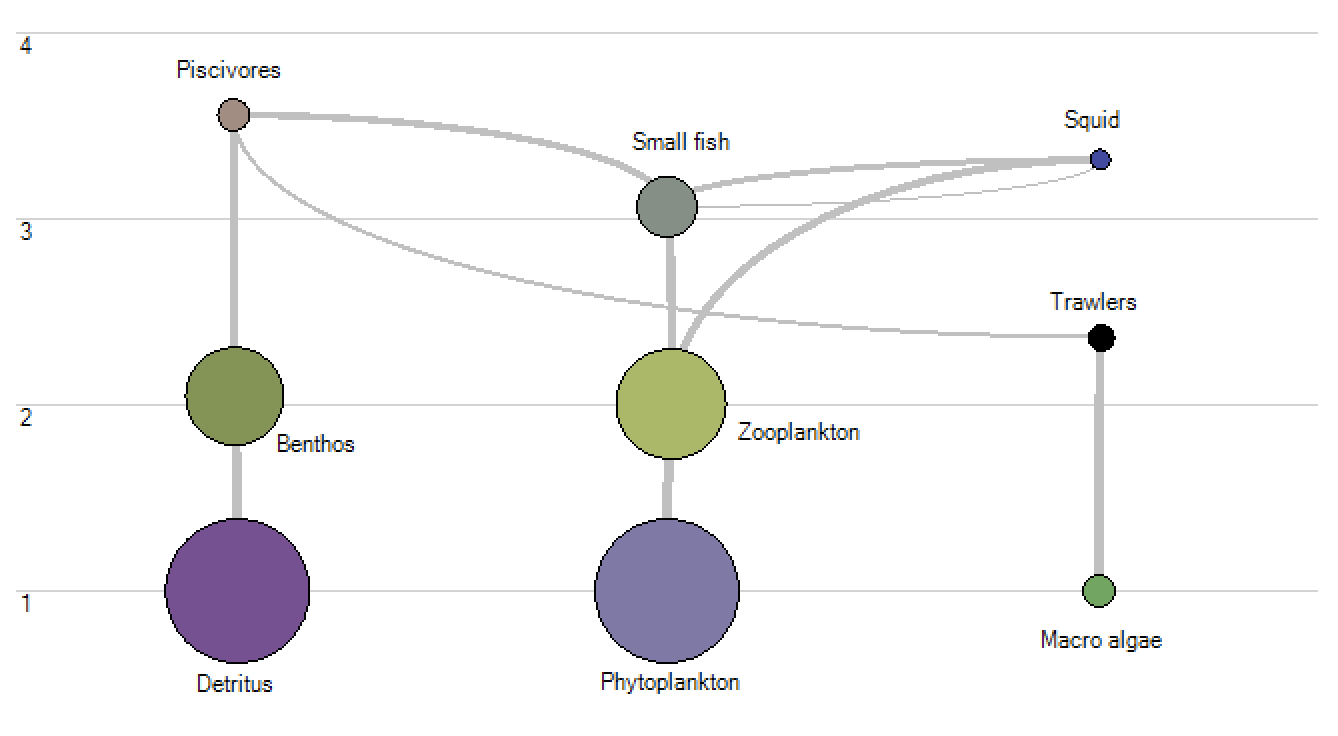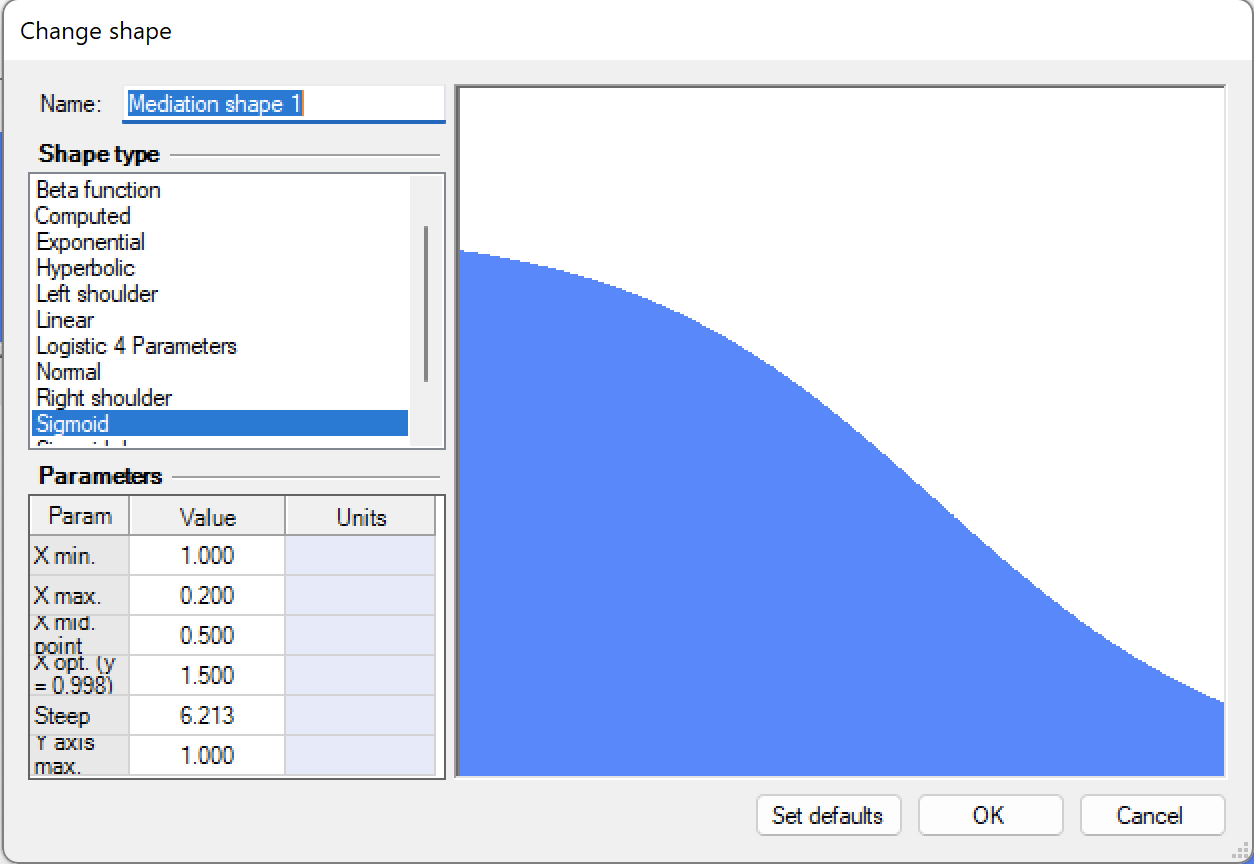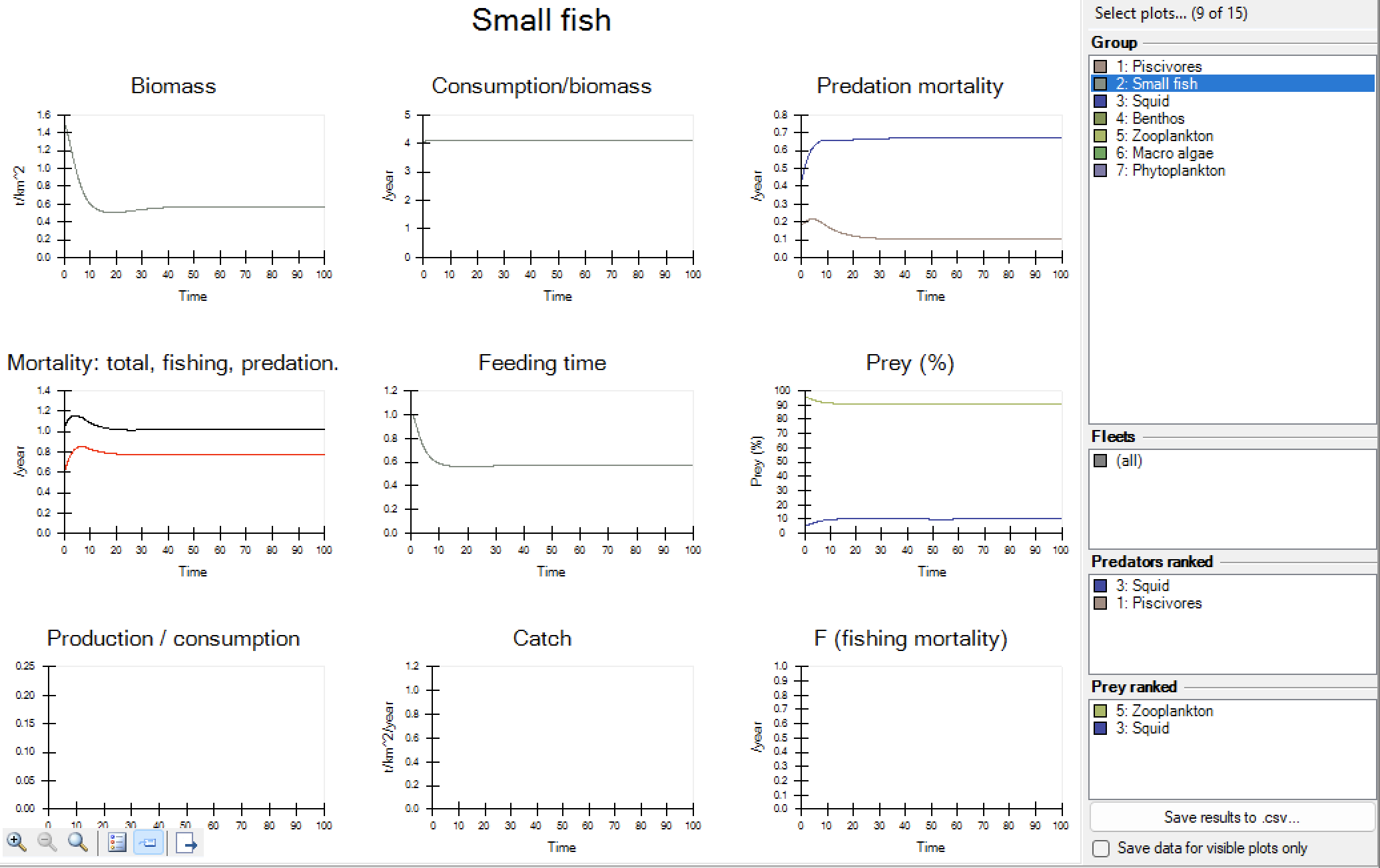Tutorial: Trawling cultivates for squid (mediation)
Before trawling became intensive on shelves, macro-algae, sponges, soft-corals, and other large habitat-forming growth was abundant and provided shelter for juvenile fishes. Bottom trawling removes the habitat structure, opening for even more intensive trawling, and often a valuable squid fishery emerges (Figure 1). Sainsbury and colleagues[1] described this process, and found that fishers would actively promote this destruction of habitat structure in order to cultivate squid fisheries. In this exercise, we will replicate the development based on a simple ecosystem model.

Figure 1. A simple flow chart (Ecopath > Output > Tools > Ecopath flow diagram) of a food web model designed to demonstrate how trawling may cultivate the ocean bottom for squid. Y-axis indicate trophic levels while the group circles perceived as round spheres (like real footballs) are proportional to group biomasses.
To model such a development, we develop a simple model illustrating how EwE can be used to analyze fisheries ecological issues. Open EwE, and Menu > File > New to create a new model. Then select Ecopath > Input > Basic input, and you will have a spreadsheet with only one group (Detritus) listed as you start out. Now click Define Groups > Insert until you have at least eight rows. Then write the group names for each of the functional groups from Table 1, and click in the Producer column for the phytoplankton and macro-algae groups. Now select ‘OK’ and the model will be saved.
Table 1. Basic input parameters for the trawl-squid model. B is biomass (in t km-2), P/B is production/biomass ratio (year-1), Q/B is consumption/biomass ratio (year-1), and EE is the ‘ecotrophic efficiency’, expressing the proportion of the production for which the fate is explained based on the model. The EE is typically used to check for mass-balance in the model.
| Group | B | P/B | Q/B | EE | |
| 1 | Piscivores | 0.5 | 0.3 | 1 | |
| 2 | Small fish | 1.5 | 1 | 4 | |
| 3 | Squid | 0.2 | 2 | 10 | |
| 4 | Benthos | 4 | 5 | 20 | |
| 5 | Zooplankton | 5 | 20 | 80 | |
| 6 | Macro algae | 0.5 | 0.5 | 1 | |
| 7 | Phytoplankton | 10 | 150 | ||
| 8 | Detritus | 10 |
You should now have a model with eight groups listed, and you should now enter the basic input parameter values from Table 1. Next select Ecopath >Input > Diet composition and enter the diet compositions from Table 2.
Table 5.2. Diet composition for the trawl-squid model, given as proportions (by weight or volume). Predators are listed in columns.
| Prey \ Predator | 1 | 2 | 3 | 4 | 5 |
| Piscivores | |||||
| Small fish | 0.50 | 0.30 | |||
| Squid | 0.05 | ||||
| Benthos | 0.50 | 0.05 | |||
| Zooplankton | 0.95 | 0.70 | |||
| Macro-algae | |||||
| Phytoplankton | 1.00 | ||||
| Detritus | 0.95 | ||||
| Import | |||||
| Sum | 1.00 | 1.00 | 1.00 | 1.00 | 1.00 |
Continue to the Ecopath > Input > Fishery > Fleets > Define fleets, and change the name from Fleet1 to Trawlers. Next, go to Ecopath > Input > Fishery > Landings and enter a landing of 0.05 t · km-2 · year-1 of piscivores. Continue to Ecopath > Input > Fishery > Discards and enter a discard of 0.3 t · km-2 · year-1 of macro algae. Next go to Ecopath > Input > Fishery > Discard fate, and specify that all the discards will go to the detritus box, (i.e. enter 1.0 on the form).
You have now entered all the input parameters that are required for the model. You may notice on the Ecopath > Input > Basic input form that all possible (i.e. not blocked as indicated with a yellow background color) input parameters have been entered for macro algae, i.e. biomass (B, t · km-2), production/biomass (P/B, year-1) ratio and ecotrophic efficiency (EE). By entering all the basic input parameters, you are tweaking the second Ecopath Master Equation (see chapter). Where we in most cases seek to estimate either EE, we have here for macro-algae entered the EE and Ecopath can estimate M2 (predation mortality), F (fishing mortality = catch / biomass), and P/B, so to ensure mass-balance, Ecopath will instead estimate either the biomass accumulation (BA) or net migration term (NM).
Next step is to balance the model, select Ecopath > Output > Basic estimates.
Having entered all basic input parameters for macro-algae EwE will ask if you want to estimate biomass accumulation for the group. You do, as macro-algae were being fished and discarded by the trawlers, and we expect their biomass to be declining in the base Ecopath-situation. This will open the results form, recognizable by the grid background being shaded, and by parameters estimated through the Ecopath mass-balance calculations being shown in blue font.
In this example the model will balance as entered (unless you made a mistake). You can try, however, to see the impact of impossible or unlikely values, e.g., by going back to Ecopath > Input > Basic input, and change the biomass estimate for piscivores to 5 t · km-2. You will now get a warning that EE for small fish exceed 1. Go Ecopath > Output > Mortality rates > Mortalities, and note that for small fish the instantaneous predation mortality rate is shown in red to indicate that it exceeds the total mortality rate. Check Ecopath > Output > Mortality rates > Predation mortality rates to see the breakdown of the predation mortality, and it is clear that the problem with too high predation mortality is linked to the piscivores. No big wonder, we increased their biomass with an order of magnitude, and this comes back to haunt us. So, change the biomass for piscivores back to 0.5 t · km-2 to re-balance the model.
When we next continue to the time-dynamic simulation model, Ecosim, it will pick up that there is a negative biomass accumulation term for macro algae. So, go Ecosim > Output > Run Ecosim, and enter a title for a scenario, e.g., Base simulation. Ecosim will save all parameters it requires for a run as part of this scenario, and this way you can easily store alternative scenarios.
Now click the Run command button, thus running Ecosim ‘as is’, i.e. with default parameter settings. The graph will show how biomasses are predicted to change relative to the Ecopath-baseline biomasses. You should see the biomass of macro-algae decreasing asymptotically. This is a consequence of us having ‘told’ the model (by specifying a negative biomass accumulation term) that in the baseline situation, the macro-algae were decreasing with a given rate.
Why don’t macro algae just continue to extinction? With the default parameter setting there is assumed to be a density-dependent compensation for the producer group. As some macro algae are removed through fishing, those remaining get better conditions. You can change this prediction at Ecosim > Group Info by changing the Max relative P/B for macro-algae from the default 2.0 to, e.g., 1.01, to indicate that there will not be any density-dependent compensation. Re-run Ecosim – and macro-algae will be heading toward extension.
What is then the ‘right’ value to use for this parameter? Sorry, that is your problem, you are the one who needs to know about the groups in your systems, and we highlight this to strengthen what was stressed earlier: nothing substitutes data; at least not the kind of data that leads to knowledge.
In the simulation up to now (the Base simulation scenario) only the macro-algae were impacted by the trawling, for the rest a status-quo situation is predicted. We can modify this by invoking a process known as mediation (see chapter). Mediation is here defined as a process where a group has a non-trophic impact on the trophic interactions of other groups in the system. In our case, the macro-algae serve as hiding places for small fish; they can hide for the piscivores and the squid that feed upon them.
Let us model this with a new scenario. First save your model (Menu, File > Save Model), then select Menu, Ecosim > New scenario, and enter a scenario title, e.g., “with mediation”.
Next go to Ecosim > Input > Mediation. In the lower left panel, click Add to add a mediation shape. Next, in the lower right panel, click Define mediating groups and fleets… ’ click macro-algae, the right arrow and OK. This defines the X-axis of Mediation shape 1 as being the biomass of macro-algae. Next change the shape of Mediation shape 1 by in the top panel clicking Change shape, selecting Sigmoid and enter values as on Figure 2.

Figure 2. Mediation shape for macro algae impacting piscivore predation on small fish as well as the interaction between squid and small fish.
We now have to apply the mediation shape. Go to Ecosim > Input > Mediation > Apply mediation (consumer) and click the interaction between piscivores and small fish (column 1, row 2). On the ‘Apply FF and mediation functions’ form that pop up, click Mediation shape 1, the right arrow, Vulnerability radio button, and OK. Perform the same operation for the cell indicating interaction between squid and small fish

Figure 3. Screen shot from Ecosim, showing a sigmoid mediation function that is used to impact the interaction between piscivores & squid and small fish as a function of macro algae biomass (x-axis). The stippled vertical line indicates the Ecopath baseline situation, and has here been moved to the right by clicking on the graph and moving it. Lower biomass of macro-algae will cause higher feeding interaction between piscivores and small fish, higher biomass lower. So, with the stippled line where it is, it indicates that completely eradicating macro algae would make small fish ~3 x more vulnerable to their predators.
We now have defined that if the biomass of macro-algae is lowered there will be more interaction (higher vulnerability) between piscivores and small fish, and also that this will lead to more predation by squid on small fish. Run the simulation again (Ecosim > Output > Run Ecosim >Run), and see what happens now.

Figure 3. Ecosim > Output > Group plot for small fish. The predation mortality plot shows increased predation by squid and decreased predation by piscivores. The group plots are very informative about your model and great to explore.
Macro-algae will decline as before, this will cause small fish biomass to decrease because of increased predation from piscivores and squid. You can check that this is actually what is happening at Ecosim > Output > Ecosim group plots > Small fish, to see the plot with predation over time for the small fish. The lower abundance of small fish next causes their major predator, piscivores, to decline for lack of food, and the squid, which are released from the predation pressure caused by small fishes, and which are losing a competitor in form of the same group, increases their biomass. Fishing effort is constant, so that’s causing the change for the piscivores.
You can download the model for this chapter at this link.
Attribution
This chapter is adapted and updated from Christensen, V. 2009. Ecopath with Ecosim: Linking fisheries and ecology. Page 55-70, Chapter 5 in: S. E. Jørgensen, T-S Chon, F.A. Recknagel (Editors) Handbook of Ecological Modelling and Informatics. WIT Press
- Sainsbury, K.J., R.A. Campbell, and W.W. Whitelaw, Effects of trawling on the marine habitat on the North West Shelf of Australia and implications for sustainable fisheries management, in Sustainable Fisheries through Sustainable Habitat, D.A. Hancock, Editor. 1993, Bureau of Rural Sciences Proceedings, AGPS: Canberra. p. 137-145. ↵

